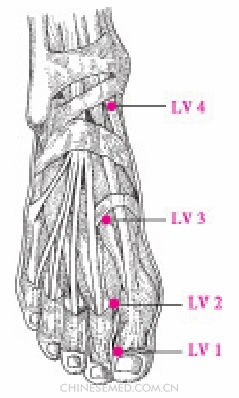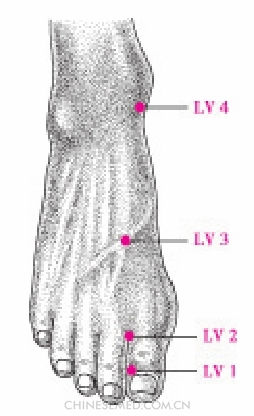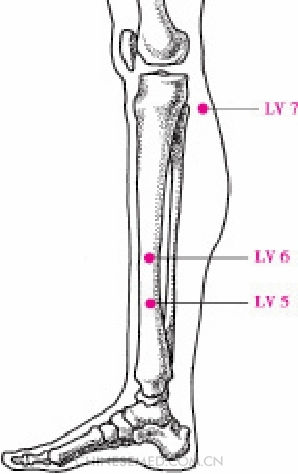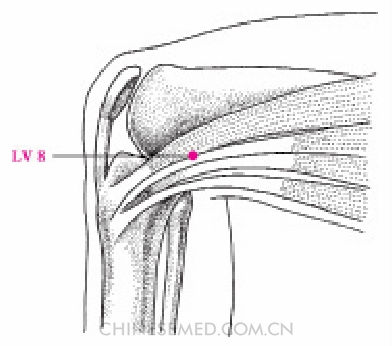The foot jueyin liver channel has 14 bilateral points: 12 on the medial aspect of the lower limbs and 2 on the chest and hypochondrium. The first is lateral to the distal phalanx of the big toe, LV 1 (dà dūn); the last is on the thorax in the sixth intercostal space, LV 14 (qī mén). Indications include conditions of the head, ears, eyes, throat, and mind as well as febrile disorders and conditions of the running course of the channel.
LV 1 (Dà Dūn, 大敦)
Jing-well point
Location. On the great toe lateral to the distal phalanx, 0.1 cun proximal to the lateral corner of the toenail (Pic. 3-86).


Location.method. The point is at the junction of a straight line along the lateral corner of the nail and a horizontal line along the bottom of the nail.
Actions. Restore yang to save from collapse, regulate menstruation, and relieve strangury.
Indications. Irregular menstruation, amenorrhea, fooding and spotting, prolapse of the uterus, other gynecologic disorders; enuresis, retention of urine, other urinary conditions; hernia, lower abdominal pain; epilepsy, somnolence.
Manipulation. Acupuncture: 1. Needle obliquely 0.1~0.2 cun; local soreness and pain can be felt. 2. Bleed with a three-edged needle. Moxibustion: Use 3~5 cones of cone moxibustion, or use a moxa stick for 5~10 minutes.
Precautions. Scarring moxibustion is prohibited.
Annotation. The point appeared in The Spiritual Pivot-Fundamental Points (Líng Shū-Běn Shū,灵枢·本输). Dūn means thick; the point is at the end, the thickest part, of the great toe, where the foot jueyin channel begins and the channel qi is at its strongest; hence the name dà dūn, big mound.
Modern clinical application and research. In a case series on dysfunctional uterine bleeding, 60 patients were treated with fve cones of direct moxibustion on LV 1 (dà dūn) once a day or every other day; fve treatments constituted a course. After two courses, bleeding significantly subsided. Of the 40 patients who returned for a six-month follow up, 28 (70%) had had no recurrence; 6 (15.0%) had benefited; 6 had not benefited (15.0%).1
LV 2 (Xíng Jiān, 行间)
Ying-spring point
Location. On the dorsum of the foot between the first and second toes, proximal to the web and at the border of the red and white fesh (Pic. 3-86).
Actions. Calm the liver and subdue yang, drain heat and calm the mind, cool blood and stanch bleeding.
Indications. Headache; dizziness; redness; eye swelling and pain; optic atrophy; deviation of the mouth; other disorders of head, face, and fve sensory organs due to wind heat in the liver channel; stroke, epilepsy, convulsion, other conditions due to wind; coughing of blood, spitting of blood, nosebleed, other blood disorders; pain of the vulva, strangury, seminal emission, impotence, pruritus vulvae, other conditions of the external genitalia; dysmenorrhea, flooding and spotting, profuse menstruation, amenorrhea, abnormal vaginal discharge, other gynecological disorders; distending pain in chest and hypochondrium, cough, asthma.
Manipulation. Acupuncture: Needle perpendicularly or obliquely 0.5~0.8 cun. The needling sensation can be felt locally and can pass to the dorsum of the foot. Moxibustion: Use 3~5 cones of cone moxibustion, or use a moxa stick for 5~10 minutes.
Precautions. See LV 1 (dà dūn).
Annotation. The point appeared in The Spiritual Pivot-Fundamental Points (Líng Shū-Běn Shū,灵枢·本输). Xíng means travel. The point is on the margin of the web between the first and second toes where channel qi enters. Thus the point is called xíng jiān, travels between.
LV 3 (Tài Chōng, 太冲)
Shu-stream point; yuan-source point of the liver
Location. On the dorsum of the foot between the first and second metatarsal bones in the depression distal to the junction of the bases of the two bones and over the dorsalis pedis artery (Pic. 3-86).
Location.method. The point can be felt in the depression when moving the fnger proximally from LV 2 (xíng jiān) in the gap between the first and second metatarsal bones toward the base of two metatarsal bones.
Actions. Calm the liver and extinguish wind, soothe the liver and nourish blood.
1 Zhang L, Jia CS. Sixty cases of dysfunctional uterine bleeding cured by moxibustion on LV 1 (dà dūn) 艾炷灸大敦穴为主治疗功能失调性子宫出血60例. Chinese Acupuncture & Moxibustion. 2004; 24(8): 550.
Indications. Stroke, depressive psychosis, manic psychosis, infantile convulsion, insomnia, headache, dizziness, deviation of the mouth, redness, swelling and pain of the eyes, tinnitus, sore throat, other wind heat disorders of the liver channel; jaundice, hypochondrial pain, abdominal distension, vomiting, other liver and stomach conditions; vaginal pain, inguinal hernia, strangury, other external genital disorders; irregular menstruation, dysmenorrhea, amenorrhea, flooding and spotting, abnormal vaginal discharge, difficult delivery, breast pain, other gynecological conditions; enuresis, retention of urine; lower limb weakness or paralysis, swelling and pain of the back of the foot.
Manipulation. Acupuncture: 1. Needle obliquely upward 0.5~1 cun. Local soreness and distention can be felt, and numbness can spread to the sole. 2. Needle obliquely downward 1.0~1.5 cun to penetrate KI 1 (yŏng quán). An electric numbness might spread to the sole. Moxibustion: Use 3~5 cones of cone moxibustion, or use warming needle moxibustion for 20 minutes, or use a moxa stick for 10~20 minutes.
Annotation. The point appeared in The Spiritual Pivot-Fundamental Points (Líng Shū-Běn Shū,灵枢·本输) and is the yuan-source point of the liver channel, where the chong mai branches. Tài means large; chōng means abundant. Where the two channels meet, qi becomes large and abundant, so the point is called tài chōng, large abundant.
Modern clinical application and research. In a case series on acupuncture for migraine in 90 patients, KI 1 (yŏng quán) was threaded to LV 3 (tài chōng) and local ashi points on the head were added; needles were retained for 30 minutes and twirled every 10. EA at 3.3 Hz was applied at the ashi points. Treatment was given once a day; two ten-day courses with two days between them were given, then a second course was administered. The researchers reported a total effective rate of 93.5% was found following these treatments.1
LV 4 (Zhōng Fēng, 中封)
Jing-river point
Location. On the anteromedial aspect of ankle in the depression medial to the tibialis anterior tendon and anterior to the medial malleolus (Pic. 3-86).
Actions. Clear the liver and gallbladder heat, promote the lower jiao, soothe tendons and quicken collaterals.
Indications. Hernia, seminal emission; difficulty in urinating; internal malleolus pain, cold foot, lower abdominal pain, dry throat, headache, other disorders of the running course.
Manipulation. Acupuncture: Needle perpendicularly 0.5~0.8 cun. Local soreness and distention can be felt and can spread to the dorsum of the foot. Moxibustion: Use 3~5 cones of cone moxibustion, or use warming needle moxibustion for 20 minutes, or use a moxa stick for 5~10 minutes.
Precautions. Avoid puncturing the veins and nerves, needle perpendicularly and close to the medial border of the tendon of m. tibialis anterior.
Annotation. The point appeared in The Spiritual Pivot-Fundamental Points (Líng Shū-Běn Shū,灵枢·本输) and is anterior to the medial malleolus. Fēng means boundary. The medial border of the m. tibialis anterior tendon separates the tendon from the malleolus; thus the point is called zhōngfēng, middle boundary.
LV 5 (Lí Gōu, 蠡沟)
Luo-connecting point
Location. On the anteromedial aspect of the leg at the center of the medial border of the tibia, 5 cun proximal to the prominence of the medial malleolus (Pic. 3-87).
Location.method. The point is at the center of the medial border of the tibia at the level of KI 9 (zhù bīn) and level with the upper two thirds and lower one third of a line connecting the apex of the patella and the prominence of the medial malleolus.
1 Jin BL, Tang WL, Zhou M, Wang XY. Observation of migraine treated by acupuncture with KI 1 (yŏng quán) toward LV 3 (tài chōng) as the major point combination涌泉透太冲为主治疗偏头痛疗效观察. Shanghai Journal of Acupuncture and Moxibustion. 2009; 28(3): 158-9.
Actions. Soothe the liver and rectify qi, regulate menstruation and arrest vaginal discharge.
Indications. Hernia, enuresis, retention of urine, vaginal pain, vaginal itching, other of the external genital disorders; irregular menstruation, abnormal vaginal discharge, prolapse of the uterus, fooding and spotting, other gynecologic conditions; difficult urination; cold foot, leg pain.

Manipulation. Acupuncture: Needle transversely 0.5~ 0.8 cun. Local soreness and distention can be felt. Or needle obliquely upward along the posterior border of the tibia 1.0~1.5 cun; soreness and distention can spread to the knee. Moxibustion: Use 3~5 cones of cone moxibustion, or use a moxa stick for 5~10 minutes.
Annotation. The point appeared in The Spiritual Pivot-Channels (Líng Shū-Jīng Mài, 灵枢·经脉). Lí means gourd ladle. The point is 5 cun above the medial malleolus; the nearby area is like a ladle, so the point is called lí gōu.
LV 6 (Zhōn⁝ Dū, 中都)
Xi-cleft point
Location. On the anteromedial aspect of the leg at the center of the medial border of the tibia, 7 cun superior to the prominence of the medial malleolus (Pic. 3-87).
Actions. Soothe the liver and rectify qi, regulate menstruation and stanch bleeding.
Indications. Abdominal pain and distention, hernia; flooding and spotting, persistent flow of lochia, other gynecological disorders; diarrhea.
Manipulation. Acupuncture: Needle transversely 0.5~0.8 cun. Local soreness and distention can be felt and can spread to the knee. Moxibustion: Use 3~5 cones of cone moxibustion, or use warming needle moxibustion for 20 minutes, or use a moxa stick for 5~10 minutes.
Annotation. The point appeared in The Systematic Classic of Acupuncture and Moxibustion (Zhēn Jiŭ Jiă Yĭ Jīng, 针灸甲乙经). Dū means dwelling. The point is in the middle of the tibia, so it is called zhōng dū, middle dwelling.
LV 7 (Xī Guān, 膝关)
Location. On the tibial aspect of the leg inferior to the medial condyle of the tibia, 1 cun posterior to SP 9 (yīn líng quán) (Pic. 3-87).
Actions. Dispel wind, eliminate dampness, and lubricate joints.
Indications. Knee swelling and pain, arthritis, atrophy or paralysis of the lower limbs.
Manipulation. Acupuncture: Needle perpendicularly 0.8~1.0 cun. Local soreness and distention can be felt, and an electric numbness can spread to the sole of the foot. Moxibustion: Use 3~5 cones of cone moxibustion, or use warming needle moxibustion for 20 minutes, or use a moxa stick for 10~20 minutes.
Annotation. The point appeared in The Systematic Classic of Acupuncture and Moxibustion (ZhēnJiŭ Jiă Yĭ Jīng, 针灸甲乙经). Located near the knee, it treats pain of the medial aspect of the knee and inability to bend and stretch the knee, so it is called xī guān, knee joint.
LV 8 (Qū Quán, 曲泉)
He-sea point
Location. On the medial aspect of the knee in the depression medial to the tendons of the semitendinosus and the semimembranosus muscles at the medial end of the popliteal crease (Pic. 3-88).

Location.method. With the patient’s knee flexed, the point is in the depression medial to the most prominent tendon on the medial end of the popliteal crease.
Actions. Soothe the liver and rectify qi, regulate menstruation and relieve pain.
Indications. Irregular menstruation, dysmenorrhea, abnormal white vaginal discharge, prolapse of the uterus; hernia, impotence, seminal emission; difficult urination; knee pain and swelling, atrophy or paralysis of the lower limbs.
Manipulation. Acupuncture: Needle perpendicularly 1.0~1.5 cun. The needle may be angled toward GB 33 (xī yáng guān). Local soreness and distention can be felt and can spread to the knee, and an electric numbness can go downward. Moxibustion: Use 3~5 cones of cone moxibustion, or use warming needle moxibustion for 20 minutes, or use a moxa stick for 5~10 minutes.
Precautions. Deep needling can injure the popliteal artery and vein. Scarring moxibustion is inadvisable.
Annotation. The point appeared in The Spiritual Pivot-Fundamental Points (Líng Shū-Běn Shū,灵枢·本输). Qū means bending. Quán means spring. The point is at the crook of the knee; as the he-sea point of the liver channel, it belongs to water. Therefore it is called qū quán, bending spring.
LV 9 (Yīn Bāo, 阴包)
Location. On the medial aspect of the thigh between the gracilis and the sartorius muscles, 4 cun proximal to the base of the patella (Pic. 3-89).
Actions. Promote urination, relieve strangury, regulate menstruation, and relieve pain.
Indications. Irregular menstruation, lower abdominal pain caused by lumbosacral pain.
Manipulation. Acupuncture: Needle perpendicularly 0.8~1.0 cun. Local soreness and distention can be felt. Moxibustion: Use 3~5 cones of cone moxibustion, or use moxa stick for 10~20 minutes.
Annotation. The point appeared in The Systematic Classic ofAcupuncture and Moxibustion (Zhēn Jiŭ Jiă Yĭ Jīng, 针灸甲乙经). Yīn means the medial aspect of the thigh. Bāo means contain. The point is between two tendons on the medial aspect of the thigh and between the kidney and spleen channels, so it is called yīn bāo, yin containing.
LV 10 (Zú Wǔ Lǐ, 足五里)
Location. On the medial aspect of the thigh over the artery, 3 cun distal to ST 30 (qì chōng) (Pic. 3-89).

Actions. Soothe the liver and rectify qi, clear heat and drain dampness.
Indications. Difficult urination, lower abdominal pain and distention, swelling pain of the testicles, prolapsed uterus, somnolence, lassitude of the four limbs.
Manipulation. Acupuncture: Needle perpendicularly 0.5~0.8 cun. Local soreness and distention can be felt and can spread to the anterolateral area of the thigh. Moxibustion: Use 3~5 cones of cone moxibustion, or use warming needle moxibustion for 20 minutes, or use a moxa stick for 5~10 minutes.
Precautions. Do not injure the arteries and veins. Scarring moxibustion is inadvisable.
Annotation. The point appeared in The Systematic Classic of Acupuncture and Moxibustion (ZhēnJiŭ Jiă Yĭ Jīng, 针灸甲乙经). Its primitive name was wǔ lǐ. In order to distinguish it from the wǔ lǐ of the hand yangming large intestine channel, Comprehensive Recording of Divine Assistance (ShèngJì Zŏng Lù, 圣济总录) renamed it. Lǐ means reside. The point is 5 cun above SP 11 (jī mén) and is the fifth point of the liver channel. Therefore it is called zú wǔ lǐ, foot 5 cun.
LV 11 (Yīn Lián, 阴廉)
Location. On the medial aspect of the thigh, 2 cun distal to ST 30 (qì chōng) (Pic. 3-89).
Actions. Regulate menstruation and arrest vaginal discharge, unblock channels and quicken collaterals.
Indications. Irregular menstruation, abnormal vaginal discharge, lower abdominal pain, pain of the medial aspect of the thigh, lower limb spasms.
Manipulation. Acupuncture: Needle perpendicularly 0.8~1.0 cun. Local soreness and distention can be felt and can pass the medial aspect of thigh and knee. Moxibustion: Use 3~5 cones of cone moxibustion, or use warming needle moxibustion for 20 minutes, or use a moxa stick for 5~10 minutes.
Precautions. See LV 10 (zú wǔ lǐ).
Annotation. The point appeared in The Systematic Classic of Acupuncture and Moxibustion (ZhēnJiŭ Jiă Yĭ Jīng, 针灸甲乙经). Lián means lateral. The point is on the medial aspect of the thigh beside the external genitalia, so is called yīn lián, yin lateral.
LV 12 (Jí Mài, 急脉)
Location. In the groin region at the level of the superior border of the pubic symphysis and 2.5 cun lateral to the anterior median line (Pic. 3-89).
Actions. Soothe the liver and gallbladder, and rectify the lower jiao.
Indications. Lower abdominal pain, hernia, pain of the penis, prolapsed uterus.
Manipulation. Acupuncture: Needle perpendicularly 0.8~1.0 cun. Local soreness and distention can be felt and can spread to the external genitalia. Moxibustion: Use 3~5 cones of cone moxibustion, or use warming needle moxibustion for 20 minutes, or use a moxa stick for 5~10 minutes.
Precautions. See LV 10 (zú wǔ lǐ).
Annotation. The point appeared in Basic Questions-Treatise on Qi Mansion (Sù Wèn-Qì Fǔ Lùn,素问·气府论). Jí means rapid. The point is in the pubic hair near the artery, which beats rapidly. Therefore the point is called jí mài, rapid pulse.
LV 13 (Zhāng Mén, 章门)
Front-mu point of the spleen; influential point of the zang organs; intersecting point of the liver and gallbladder channels
Location. On the lateral abdomen below the free extremity of the 11th rib (Pic. 3-90).
Location.method. With the elbow bent and the patient supine or lying on one side, the point is on the midaxillary line at the tip of the elbow.
Actions. Soothe the liver, fortify the spleen, direct counterflowing qi downward, and relieve panting.
Indications. Vomiting, abdominal pain, abdominal distention, borborygmus, diarrhea, protracted dysentery, constipation, other spleen and stomach disorders; lack of strength in the four limbs, hypochondrial pain, jaundice, abdominal masses, other liver and spleen conditions.
Manipulation. Acupuncture: Needle obliquely 0.5~0.8 cun. Soreness and distention can be felt at the lateral abdomen and can spread to the posterior wall of the abdomen. Moxibustion: Use 5~9 cones of cone moxibustion, or use a moxa stick for 10~20 minutes.

Precautions. It is important to match the depth of insertion to the thickness of the abdominal wall in order not to injure the abdominal cavity and its organs. Patients with splenomegaly need special attention.
Annotation. The point appeared in The Pulse Classic (MàiJīng, 脉经) and is the key point for treating zang organ disorders. Zhāng means grand. Mén means door, the place of entering and exiting. The point is the front-mu point of the spleen and the influential point of the zang organs.The qi of the foot jueyin liver channel joins with the qi of the fve zang organs at this point, which is the gate by which zang qi enters and exits. Therefore, the point is called zhāng mén, grand door.
LV 14 (Qī Mén, 期门)
Front-mu point of the liver; intersecting point of the foot jueyin, foot taiyang, and yinwei channels
Location. In the anterior thorax in the sixth intercostal space, 4 cun lateral to the anterior median line (Pic. 3-90).
Location.method. The point is inferior to the center of the nipple, 2 cun lateral to ST 19 (bùróng). In females, it is at the intersection of the midclavicular line and the sixth intercostal space.
Actions. Calm the liver and subdue yang, soothe the liver and fortify the spleen.
Indications. Fullness of chest and hypochondrium, chest heat, cough, asthma, shortness of breath, other disorders of chest and hypochondrium; cutting epigastric pain, poor appetite, vomiting, hiccup, hardness of the abdomen due to indigestion, watery diarrhea due to cholera, dysentery, qi going upward to the heart, consumptive thirst; heat entering the uterus, difficult delivery, Insufficient milk, breast lump.
Manipulation. Acupuncture: Needle obliquely 0.5~0.8 cun or transversely 0.5~1.0 cun along the intercostal space. Local soreness and distention can be felt and can spread to the posterior wall of the abdomen. Moxibustion: Use 5~9 cones of cone moxibustion, or use a moxa stick for 10~20 minutes. Natural moxibustion may be used.
Precautions. Avoid penetrating the thoracic cavity and injuring the parietal pleura and lungs. It is advisable to puncture along the long axis of the rib. It is forbidden to puncture perpendicular to the long axis.
Annotation. The point appeared in Treatise on Cold Damage (Shāng Hán Lùn, 伤寒论). Qī means cycle. Mén means door, the place of entering and exiting. Qi and blood of the twelve channels circulates continuously, starting at LU 1 (zhōng fŭ) and ending at LV 1 (dà dūn). This point is the gate where qi and blood returns, so it is called qī mén, cycle gate.

